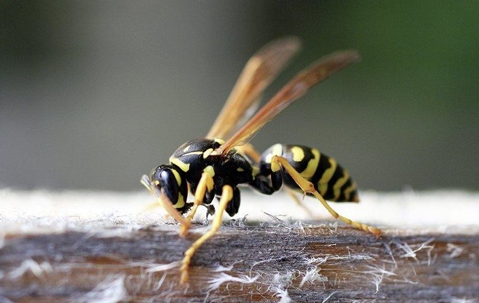Even the term hornet makes homeowners nervous. Though these stinging pests are beneficial to our ecosystem, having them in abundance on our property isn't ideal. In order to determine if you have a bald-faced hornet problem, it's important to be able to identify these insects and understand their behavior.
The bald-faced hornet is related to the yellowjacket. It gets its name from its appearance, which is primarily black with a strikingly white face. Other features include:
- Two slanted lines that run from midsection toward the head and on the latter part of their abdomen.
- The surface of its upper mid-section appears triangular.
- This species of hornet is rather large and can grow to over an inch in length.
The queen bald-faced hornet is larger than adult-workers. Their aerial nests are gray and paper-like. Their nests are enclosed unlike the open cone structure associated with other stinging hornets and insects. Bald-faced hornets' nests are generally at least three feet or more above the ground, often found in trees and shrubs, on utility poles, or hanging from homes, sheds, and barns. Nests can be as long as 24 inches and 14 inches in diameter.
Bald-faced hornet colonies will begin to appear in the spring. The queen lays a single egg inside each cell as she builds a nest. She puts insects and nectar into the cell with the egg. The eggs will hatch into larvae and soon become workers that help to expand the community. A bald-faced hornet nest can harbor as many as 700 workers.
The males will begin to show up late in the summer to fertilize newly developed females. Fertilized females search for a place to hibernate until next season comes around when they will become new queens. The remainder of the nest will die off as cold weather approaches.
Pros And Cons Of Bald Faced Hornets
There are some benefits of having bald-faced hornets on your property. Like other stinging pests, such as yellow jackets, bald-faced hornets are beneficial. They help pollinate crops, flowers, and other plants that are valuable to the ecosystem. Additionally, they are a natural enemy of other types of insects, including flies, crane flies, caterpillars, and a variety of other small insects. This is of huge value to the eco-system and can help keep the population of annoying and disease-carrying insects to a minimum.
In contrast, bald-faced hornets are dangerous. Like many other stinging pests, they can cause severe allergic reactions in people. The bald-faced hornet is highly protective of its nest and will sting repeatedly if it is disturbed. These stings can be extremely painful. If their victim is allergic to their sting, it can result in serious illness and even death.
How To Manage Bald-Faced Hornet Nests
Typically, it is unnecessary to kill bald-faced hornets unless they pose a risk. Nests that are high in trees, around the perimeter of your property, or in places where they won’t be readily disturbed are generally not a threat. If, however, there is someone who is allergic to stings living on the premises, you will want to get rid of any bald-faced hornet nests around your home. If you decide to leave a bald-faced hornet nest undisturbed on your property, it’s a good idea to mark the area to indicate the presence of the nest. This can help avoid someone accidentally stumbling upon it.
Leave The Removal Of Bald-Faced Hornets To The Professionals
Since bald-faced hornets are so aggressive when their nests are disturbed, it’s always recommended that you leave the removal of the nests to experts in the pest control industry. For removal of bald-faced hornets nests in the Quad Cities, rely on the experts at Quik-Kill Pest Eliminators. We are here to help you with the removal of bald-faced hornets and other stinging insects when you need us. Reach out to our seasoned experts at Quik-Kill today, and let us help you control your bald-faced hornet problem.

